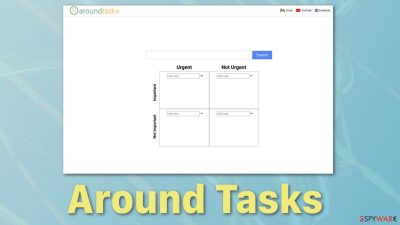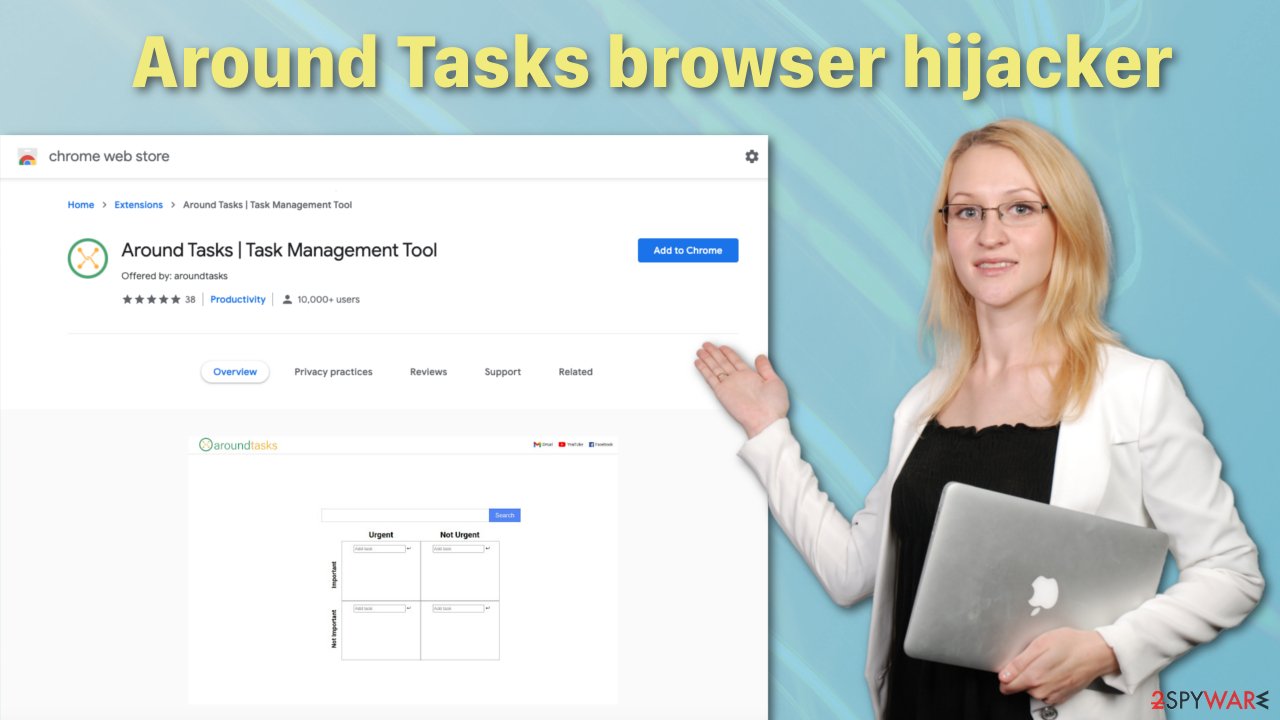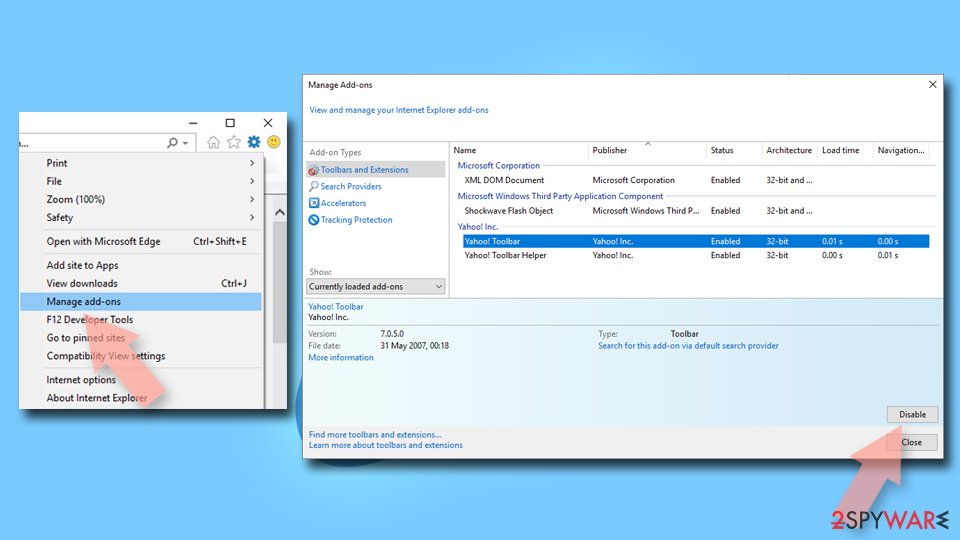Around Tasks browser hijacker (guide) - Free Instructions
Around Tasks browser hijacker Removal Guide
What is Around Tasks browser hijacker?
Around Tasks changes your new tab address and other key settings

Getting your browser hijacked is an annoying occurrence. Changed new tab address, homepage can be confusing for users who did not add the Around Tasks extension themselves. Add-ons can significantly affect the browsing experience by inserting ads, causing redirects, and altering the search results. Additionally, it can slow down the device.
Hijackers can sometimes try to appeal to users by adding some basic features to tempt users to keep the extension and not remove it. Around tasks claims to make planning, organizing, and scheduling easier for busy people. But it is simply not worth it to receive altered search results and have cookies collect your data for basic functions.
Although you can add this particular extension from the Chrome web store, browser hijackers are usually spread through bundled software[1] when users download apps from third party sources. If it is the fault of a potentially unwanted program,[2] simply changing the browser settings like the homepage back to what it was will not work. After some time, or even immediately, the browser will return to the hijacked stage.
| NAME | Around Tasks |
| TYPE | Browser hijacker |
| SYMPTOMS | Homepage and new tab addresses are changed; altered search results filled with sponsored content |
| DANGERS | Installation of potentially unwanted programs, the information provided to third parties |
| DISTRIBUTION | Deceptive ads, software bundles, app stores |
| ELIMINATION | Remove an unwanted extension via browser settings manually |
| FURTHER STEPS | Scan your machine with FortectIntego to get rid of any damage left completely |
User privacy is important to most people, but they lack the knowledge of what they can do to protect it. Around Tasks, in its website, states it adds these functions:
– State-of-the-art To-Do lists;
– Smart links to Gmail, Youtube, Facebook, Yahoo News;
– Easy scheduling process with fast redirection to New Tab;
– Convenient outlook of the recently viewed processes.
It is simply an attempt to stay relevant. Half of the things stated in the list are available on most search engines, so it is just not worth the hassle.
The add-on has the ability to monitor your browsing activity. It collects your IP address, search habits, purchases, and other information. It can provide this data to third parties, and they will not be liable for what those third parties do with your information.

Cookies help advertisers appeal to customers but are a privacy threat
Almost every website you visit asks for your permission to use cookies. It has become a habit to click “Accept” and proceed with your business quickly. These cookies are simple text files that a website can store on your browser. The main purpose is to identify users, save site login details or create customized web pages.
Most websites will use cookies as a way of creating a profile for a person. The cookies will track each time a user visits a site, what they are searching for, what they are buying, and generally provide a detailed picture of their online activity. The purpose of this is to improve the user experience and create a more relevant browsing session.
This goldmine of information could not be unseen by individuals who want to exploit it for their own gain. In 2015, Yahoo suffered from a breach that compromised the data of over 32 million users.[3] Hackers managed to break into its systems and steal the code relating to Yahoo’s use of cookies. The code enabled the hackers to forge cookies for all 32 million accounts without using a password.
The stolen user account information included names, email addresses, dates of birth, telephone numbers, hashed passwords, and in some cases, encrypted or unencrypted security questions and answers. That is, all attackers need to commit identity fraud.
Since the attack, there have been major changes in privacy laws surrounding the use of cookies. All companies within the EU are now legally bound to inform us that their site uses cookies, and we must provide our consent for this data to be used.[4]
But let's be honest, not many people will have the patience to read through the long text of how their information will be used. If you care about your privacy, it is good to clear your browsers regularly. You can do it automatically with FortectIntego, and you will not have to waste your precious time.
Remove the unwanted Around Tasks extension manually by accessing your browser settings:
Google Chrome
- Open Google Chrome, click on the Menu (three vertical dots at the top-right corner) and select More tools > Extensions.
- In the newly opened window, you will see all the installed extensions. Uninstall all the suspicious plugins that might be related to the unwanted program by clicking Remove.
![Remove extensions from Chrome Remove extensions from Chrome]()
MS Edge:
- Select Menu (three horizontal dots at the top-right of the browser window) and pick Extensions.
- From the list, pick the extension and click on the Gear icon.
- Click on Uninstall at the bottom.
![Remove extensions from Edge Remove extensions from Edge]()
MS Edge (Chromium)
- Open Edge and click select Settings > Extensions.
- Delete unwanted extensions by clicking Remove.
![Remove extensions from Chromium Edge Remove extensions from Chromium Edge]()
Mozilla Firefox
- Open Mozilla Firefox browser and click on the Menu (three horizontal lines at the top-right of the window).
- Select Add-ons.
- In here, select unwanted plugin and click Remove.
![Remove extensions from Firefox Remove extensions from Firefox]()
Safari
- Click Safari > Preferences…
- In the new window, pick Extensions.
- Select the unwanted extension and select Uninstall.
![Remove extensions from Safari Remove extensions from Safari]()
Internet Explorer:
- Open Internet Explorer, click on the Gear icon (IE menu) on the top-right corner of the browser
- Pick Manage Add-ons.
- You will see a Manage Add-ons window. Here, look for suspicious plugins. Click on these entries and select Disable.
![Remove add-ons from Internet Explorer Remove add-ons from Internet Explorer]()
You take a risk when installing freeware
If manual removal from the browser did not work and you are still experiencing symptoms, you will have to locate a potentially unwanted program in your machine and uninstall it. These programs most commonly come together with free programs you download from unofficial sources. When users rush through the installation process, they do not notice that additional apps are included as a package.
When downloading anything from the internet, it is important to go through all the steps by choosing “Advanced” or “Custom” installation methods. Read the Terms of Use and Privacy Policy, see if you like the way your information will be used. Usually, when downloading files for free, you have to trade something in return. Individuals can monetize your data, so read about it. If you see any unrelated programs in the installation window, be sure to uncheck the boxes next to them.
If you have no idea what programs could be responsible for such behavior, use SpyHunter 5Combo Cleaner or Malwarebytes anti-malware tools that will scan your machine for PUPs and delete them automatically. They can also prevent such installations in the future by warning you about suspicious programs.
If you think you can do this yourself, you can follow the step-by-step instructions below for Windows and macOS operating systems. At the bottom of this post, you will find additional helpful guides that show how to change your homepage and clear your cookies manually.
Instructions for Windows 10/8 machines:
- Enter Control Panel into Windows search box and hit Enter or click on the search result.
- Under Programs, select Uninstall a program.
![Uninstall from Windows 1 Uninstall from Windows 1]()
- From the list, find the entry of the suspicious program.
- Right-click on the application and select Uninstall.
- If User Account Control shows up, click Yes.
- Wait till uninstallation process is complete and click OK.
![Uninstall from Windows 2 Uninstall from Windows 2]()
If you are Windows 7/XP user, proceed with the following instructions:
- Click on Windows Start > Control Panel located on the right pane (if you are Windows XP user, click on Add/Remove Programs).
- In Control Panel, select Programs > Uninstall a program.
![Uninstall from Windows 7/XP Uninstall from Windows 7/XP]()
- Pick the unwanted application by clicking on it once.
- At the top, click Uninstall/Change.
- In the confirmation prompt, pick Yes.
- Click OK once the removal process is finished.
Instructions for Mac machines:
- From the menu bar, select Go > Applications.
- In the Applications folder, look for all related entries.
- Click on the app and drag it to Trash (or right-click and pick Move to Trash)
![Uninstall from Mac 1 Uninstall from Mac 1]()
To fully remove an unwanted app, you need to access Application Support, LaunchAgents, and LaunchDaemons folders and delete relevant files:
- Select Go > Go to Folder.
- Enter /Library/Application Support and click Go or press Enter.
- In the Application Support folder, look for any dubious entries and then delete them.
- Now enter /Library/LaunchAgents and /Library/LaunchDaemons folders the same way and terminate all the related .plist files.
![Uninstall from Mac 2 Uninstall from Mac 2]()
You may remove virus damage with a help of FortectIntego. SpyHunter 5Combo Cleaner and Malwarebytes are recommended to detect potentially unwanted programs and viruses with all their files and registry entries that are related to them.
Getting rid of Around Tasks browser hijacker. Follow these steps
Remove from Microsoft Edge
Delete unwanted extensions from MS Edge:
- Select Menu (three horizontal dots at the top-right of the browser window) and pick Extensions.
- From the list, pick the extension and click on the Gear icon.
- Click on Uninstall at the bottom.

Clear cookies and other browser data:
- Click on the Menu (three horizontal dots at the top-right of the browser window) and select Privacy & security.
- Under Clear browsing data, pick Choose what to clear.
- Select everything (apart from passwords, although you might want to include Media licenses as well, if applicable) and click on Clear.

Restore new tab and homepage settings:
- Click the menu icon and choose Settings.
- Then find On startup section.
- Click Disable if you found any suspicious domain.
Reset MS Edge if the above steps did not work:
- Press on Ctrl + Shift + Esc to open Task Manager.
- Click on More details arrow at the bottom of the window.
- Select Details tab.
- Now scroll down and locate every entry with Microsoft Edge name in it. Right-click on each of them and select End Task to stop MS Edge from running.

If this solution failed to help you, you need to use an advanced Edge reset method. Note that you need to backup your data before proceeding.
- Find the following folder on your computer: C:\\Users\\%username%\\AppData\\Local\\Packages\\Microsoft.MicrosoftEdge_8wekyb3d8bbwe.
- Press Ctrl + A on your keyboard to select all folders.
- Right-click on them and pick Delete

- Now right-click on the Start button and pick Windows PowerShell (Admin).
- When the new window opens, copy and paste the following command, and then press Enter:
Get-AppXPackage -AllUsers -Name Microsoft.MicrosoftEdge | Foreach {Add-AppxPackage -DisableDevelopmentMode -Register “$($_.InstallLocation)\\AppXManifest.xml” -Verbose

Instructions for Chromium-based Edge
Delete extensions from MS Edge (Chromium):
- Open Edge and click select Settings > Extensions.
- Delete unwanted extensions by clicking Remove.

Clear cache and site data:
- Click on Menu and go to Settings.
- Select Privacy, search and services.
- Under Clear browsing data, pick Choose what to clear.
- Under Time range, pick All time.
- Select Clear now.

Reset Chromium-based MS Edge:
- Click on Menu and select Settings.
- On the left side, pick Reset settings.
- Select Restore settings to their default values.
- Confirm with Reset.

Remove from Mozilla Firefox (FF)
Remove dangerous extensions:
- Open Mozilla Firefox browser and click on the Menu (three horizontal lines at the top-right of the window).
- Select Add-ons.
- In here, select unwanted plugin and click Remove.

Reset the homepage:
- Click three horizontal lines at the top right corner to open the menu.
- Choose Options.
- Under Home options, enter your preferred site that will open every time you newly open the Mozilla Firefox.
Clear cookies and site data:
- Click Menu and pick Settings.
- Go to Privacy & Security section.
- Scroll down to locate Cookies and Site Data.
- Click on Clear Data…
- Select Cookies and Site Data, as well as Cached Web Content and press Clear.

Reset Mozilla Firefox
If clearing the browser as explained above did not help, reset Mozilla Firefox:
- Open Mozilla Firefox browser and click the Menu.
- Go to Help and then choose Troubleshooting Information.

- Under Give Firefox a tune up section, click on Refresh Firefox…
- Once the pop-up shows up, confirm the action by pressing on Refresh Firefox.

Remove from Google Chrome
Delete malicious extensions from Google Chrome:
- Open Google Chrome, click on the Menu (three vertical dots at the top-right corner) and select More tools > Extensions.
- In the newly opened window, you will see all the installed extensions. Uninstall all the suspicious plugins that might be related to the unwanted program by clicking Remove.

Clear cache and web data from Chrome:
- Click on Menu and pick Settings.
- Under Privacy and security, select Clear browsing data.
- Select Browsing history, Cookies and other site data, as well as Cached images and files.
- Click Clear data.

Change your homepage:
- Click menu and choose Settings.
- Look for a suspicious site in the On startup section.
- Click on Open a specific or set of pages and click on three dots to find the Remove option.
Reset Google Chrome:
If the previous methods did not help you, reset Google Chrome to eliminate all the unwanted components:
- Click on Menu and select Settings.
- In the Settings, scroll down and click Advanced.
- Scroll down and locate Reset and clean up section.
- Now click Restore settings to their original defaults.
- Confirm with Reset settings.

Delete from Safari
Remove unwanted extensions from Safari:
- Click Safari > Preferences…
- In the new window, pick Extensions.
- Select the unwanted extension and select Uninstall.

Clear cookies and other website data from Safari:
- Click Safari > Clear History…
- From the drop-down menu under Clear, pick all history.
- Confirm with Clear History.

Reset Safari if the above-mentioned steps did not help you:
- Click Safari > Preferences…
- Go to Advanced tab.
- Tick the Show Develop menu in menu bar.
- From the menu bar, click Develop, and then select Empty Caches.

After uninstalling this potentially unwanted program (PUP) and fixing each of your web browsers, we recommend you to scan your PC system with a reputable anti-spyware. This will help you to get rid of Around Tasks browser hijacker registry traces and will also identify related parasites or possible malware infections on your computer. For that you can use our top-rated malware remover: FortectIntego, SpyHunter 5Combo Cleaner or Malwarebytes.
How to prevent from getting browser hijacker
Do not let government spy on you
The government has many issues in regards to tracking users' data and spying on citizens, so you should take this into consideration and learn more about shady information gathering practices. Avoid any unwanted government tracking or spying by going totally anonymous on the internet.
You can choose a different location when you go online and access any material you want without particular content restrictions. You can easily enjoy internet connection without any risks of being hacked by using Private Internet Access VPN.
Control the information that can be accessed by government any other unwanted party and surf online without being spied on. Even if you are not involved in illegal activities or trust your selection of services, platforms, be suspicious for your own security and take precautionary measures by using the VPN service.
Backup files for the later use, in case of the malware attack
Computer users can suffer from data losses due to cyber infections or their own faulty doings. Ransomware can encrypt and hold files hostage, while unforeseen power cuts might cause a loss of important documents. If you have proper up-to-date backups, you can easily recover after such an incident and get back to work. It is also equally important to update backups on a regular basis so that the newest information remains intact – you can set this process to be performed automatically.
When you have the previous version of every important document or project you can avoid frustration and breakdowns. It comes in handy when malware strikes out of nowhere. Use Data Recovery Pro for the data restoration process.
- ^ Will Dormann. Bundled Software and Attack Surface. Insights. Software Engineering Institute.
- ^ Adam Kujawa. Encountering the Wild PUP. Malwarebytes. Labs. Threat Analysis.
- ^ Wikipedia. Yahoo! data breaches. Wikipedia. Free Encyclopedia.
- ^ European Union. Data protection and online privacy. Europa. Consumers. Internet and telecoms.
























